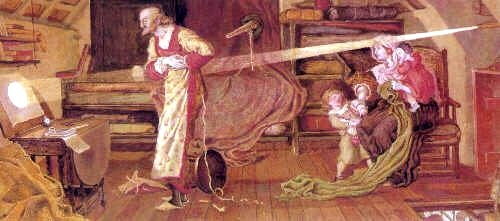

The Venus Transit 2004
... Brief InfoSheet F1
History of transit observing
1. First predictions and the transits of 1631 and 1639

William Crabtree observing the transit of Venus on 4 December 1639
Painting by Eyre Crowe - Walker Art Gallery, Liverpool
The prediction of transits of Venus and Mercury across the Sun requires a good knowledge of the orbital movements of the inner planets. This was possible from the beginning of the XVIIth century thanks to the work of Johannes Kepler (1571-1630) and to the publication in 1627 of the Rudolphine Tables, so named by Kepler in homage to his former patron, Rodolph II of Hapsburg (1552-1612), emperor of Germany. Kepler predicted a transit of Mercury on 7 November 1631 and a transit of Venus on 7 December 1631, both of which he did not live long enough to see. He also found that the transits of Venus occur about every 120 years. The transit of Mercury on 7 November 1631 was observed in Paris by the astronomer Pierre Gassendi (1592-1655). This transit was also observed by three other people: Remus Quietanus in Rouffach (Upper-Rhine, Alsace), Father Cysatus in Innsbruck (Tyrol) and an anonymous Jesuit in Ingolstadt (Bavaria). The transit of Venus, which was to occur on 6-7 December 1631, was not observed because of inaccuracies in the Rudolphine tables.
The English youth Jeremiah Horrocks (1619-1641) predicted an impending transit of Venus for Sunday, 4 December 1639 at 3 o'clock of the afternoon (24 November 1639 by the Julian calendar); this prediction disagreed with the 120-year period found by Kepler. He observed the transit from his village of Hoole (near Preston) by projecting the image of the Sun on a graduated sheet of paper and so carried out the first measurement of a transit of Venus. The transit was also observed by Horrocks' friend William Crabtree (1610-1644) in Manchester. Crabtree was so amazed by the observation that he failed to make any measurement...
In 1677, on the island of St. Helena, Edmond Halley (1656-1742) observed the transit of Mercury which took place on 7 November. He then thought of a method to determine the solar parallax and hence the Sun-Earth distance. His method is based on comparing the times of transit of Venus measured from several sites located at different latitudes. The difference between the observed transit times leads to the parallax of Venus and then to the parallax of the Sun.
Halley's method consisted of measuring the time elapsed between the first and the last interior contact of Venus with the solar disk from at least two sites having the greatest possible difference in latitude. For that, it is often necessary to travel very far and to carry out preliminary observations at the sites in order to determine accurately their geographical coordinates: latitude for deducing the parallax of the planet and longitude for synchronizing the observations. Using this method, Halley hoped to determine the solar parallax to an accuracy of one part in 500 if the observation of the contacts was made with a precision of two seconds of time. The French astronomer Joseph-Nicolas Delisle (1688-1768) proposed, in 1722, another method related to the observation of a single phase of a transit (first or last interior contact); this method increased the number of possible observing sites by adding all the places where only one phase was observable. However, it required a very good knowledge of the longitudes of the observing sites and that was difficult to obtain in the middle of the XVIIIth century.
Want to know more?
This topic is discussed in a more detailed way in the associated Extended InfoSheet.
Back to the List of Brief InfoSheets.
